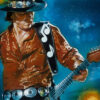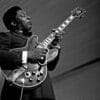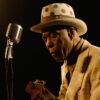Blues music greatly influenced Jimi Hendrix, shaping his unique style and guitar playing techniques. With its raw emotion and expressive guitar work, blues inspired Hendrix to develop his creative sound and push the boundaries of rock music.
Jimi Hendrix, one of the most influential musicians of all time, revolutionized the world of rock music with his groundbreaking guitar skills and innovative sound. However, few would know that his iconic style was deeply rooted in the blues. Blues music, with its soulful vocals and expressive guitar solos, served as a key influence on Hendrix’s musical journey.
By studying and emulating blues legends like Muddy Waters and B. B. King, he was able to develop his own unique style that combined the raw emotions of blues with the electrifying energy of rock. We will delve into the profound impact of blues on Jimi Hendrix and how it shaped his musical identity.
Early Influences
The early influences on the legendary guitarist Jimi Hendrix were pivotal in shaping his revolutionary musical style. Growing up in the 1940s and 50s, Hendrix was exposed to a plethora of influential blues music that would go on to profoundly impact his own artistic expression. Let’s delve into the upbringing and exposure that shaped his early experiences with the blues and explore the consequential impact it had on the development of his unique musical voice.
Upbringing And Exposure
Jim Hendrix, born in 1942, was raised in Seattle, Washington. He spent much of his childhood in the company of his grandmother, who played a significant role in cultivating his musical sensibilities. It was within this context that he was introduced to the blues. The vibrant music scene of Seattle during Hendrix’s formative years also exposed him to numerous live performances and recordings of blues legends, effectively embedding the genre into his musical DNA.
Impact Of Blues On Young Jimi
The influence of the blues on young Jimi was profound, resonating deeply with his own experiences and emotions. Throughout his adolescence, Jimi was captivated by the emotive storytelling and raw expression embodied in blues music. His immersion in this foundational genre not only shaped his understanding of music but also empowered him to infuse his own creations with the same evocative essence and raw energy that he found in the blues.
Discovering The Blues
For Jimi Hendrix, blues music was more than just a genre – it was a source of inspiration and a lifelong passion. Discovering the blues was a pivotal moment in Hendrix’s musical journey, shaping his unique style and establishing him as one of the greatest guitarists of all time.
First Encounters
From an early age, Hendrix was exposed to the sounds of blues music. Growing up in Seattle, he would often listen to artists like Muddy Waters, B.B. King, and Howlin’ Wolf. These iconic blues musicians became Hendrix’s first encounters with the genre that would leave an indelible mark on his music.
As a young guitarist, Hendrix was captivated by the emotional depth and rawness of the blues. He connected with its melancholic melodies, heartfelt lyrics, and soulful guitar playing. The blues spoke to him on a profound level, and he knew that he wanted to incorporate this powerful musical language into his own work.
Embracing The Blues Style
As Hendrix honed his skills as a musician, he began to delve deeper into the world of blues. He immersed himself in the music of blues legends like Robert Johnson, T-Bone Walker, and Albert King. Hendrix carefully studied their techniques, listening intently to their solos and rhythms.
He embraced the unique characteristics of blues music, incorporating elements such as bending notes, sliding between positions, and utilizing a wide range of expressive techniques on the guitar. Hendrix’s ability to infuse these bluesy elements into his playing set him apart from other guitarists of his time.
In addition to his guitar skills, Hendrix also embraced the emotional aspect of the blues. He was able to tap into the raw essence of the genre, channeling its pain, joy, and longing through his music. Whether it was through his searing guitar solos or heartfelt lyrics, Hendrix’s connection to the blues was palpable.
In conclusion, the blues played an integral role in shaping Jimi Hendrix’s musical identity. His discovery of this genre allowed him to develop a unique and innovative style that influenced countless musicians. Hendrix’s ability to blend the complexities of the blues with his own artistic vision is what makes his music so timeless and enduring.
| Key Points: |
| 1. Jimi Hendrix discovered the blues at a young age, listening to artists like Muddy Waters and B.B. King. |
| 2. He studied the techniques of blues legends like Robert Johnson and Albert King. |
| 3. Hendrix incorporated bluesy elements into his own guitar playing, setting him apart from other musicians. |
| 4. He connected with the emotional depth of the blues, channeling its pain and longing in his music. |
| 5. The blues influenced Hendrix’s unique and innovative style, making him one of the greatest guitarists of all time. |
Blues Guitar Techniques
Blues guitar techniques played a pivotal role in shaping the music of legendary guitarist Jimi Hendrix. The raw and emotive nature of blues music resonated with Hendrix, inspiring him to incorporate these techniques into his own unique style. From borrowing techniques from blues legends to developing his own signature sound, Hendrix’s journey with blues music helped him revolutionize the world of guitar playing.
Borrowing From Blues Legends
Hendrix was heavily influenced by blues legends such as Muddy Waters, B.B. King, and Albert King. He admired their soulful playing style and sought to emulate their techniques on the guitar. Hendrix studied their use of bends, slides, and vibrato, incorporating these elements into his own playing.
In his quest to master the blues, Hendrix even went on to cover songs written by these legends. He infused his renditions with his own artistic vision, creating one-of-a-kind musical experiences. By borrowing from the blues greats, Hendrix established a solid foundation for his guitar technique and paved the way for his future experimentation.
Developing His Own Style
While Hendrix drew inspiration from blues guitarists who came before him, he ultimately developed a guitar style that was entirely his own. He combined elements of blues with rock, funk, and psychedelia, creating a genre-defying sound that captivated audiences worldwide.
Hendrix’s unique approach to playing the guitar involved the innovative use of techniques like feedback, controlled distortion, and string-bending. He pushed the boundaries of what was considered possible on the instrument, leaving a lasting impact on the world of music.
His mastery of the blues guitar techniques, coupled with his distinctive creativity, allowed Hendrix to craft iconic solos and memorable riffs that continue to inspire generations of guitar players.
In conclusion, the influence of blues music on Jimi Hendrix cannot be overstated. By borrowing techniques from blues legends and developing his own style, he pushed the boundaries of guitar playing and forever changed the landscape of popular music. Hendrix’s legacy continues to be felt today, making him an enduring icon of rock and blues.
Fusion Of Blues And Rock
The fusion of blues and rock was a pivotal development in the music industry, impacting legendary artists like Jimi Hendrix. This seamless blending of two distinct genres opened up endless possibilities for musicians, propelling them to create groundbreaking sounds that resonate to this day.
Blending Genres
Jimi Hendrix’s music was deeply rooted in the blues, allowing him to skillfully blend the raw emotion and storytelling of blues with the electrifying energy of rock. This fusion enabled him to reach a wider audience while maintaining the authenticity of the blues genre.
Innovative Sound
Hendrix’s innovative approach to combining blues and rock resulted in a truly unique sound that captivated listeners and cemented his status as a musical trailblazer. His use of distortion, feedback, and improvisation brought a fresh dimension to the traditional blues, captivating fans worldwide.
Lyricism And Storytelling
The influence of blues music on Jimi Hendrix’s songwriting is undeniable, particularly when it comes to the lyricism and storytelling in his music. The blues, with its raw and emotive lyrics, allowed Hendrix to express himself in a way that resonated with audiences and showcased his unparalleled talent.
Influence On Songwriting
The influence of blues music on Jimi Hendrix’s songwriting is evident in the way he incorporated blues elements into his compositions.
When crafting his songs, Hendrix often drew inspiration from the lyrical content found in blues music. He understood the power of storytelling and used it to captivate listeners.
| Lyricism | Storytelling |
| The blues allowed Hendrix to express his deepest emotions through his lyrics, communicating universal themes of love, loss, and struggle. | Through his songs, Hendrix painted vivid pictures, transporting listeners into his world and immersing them in the stories he told. |
| The rawness and honesty of blues lyrics influenced Hendrix’s own lyrical style, giving his songs a genuine and relatable quality. | Hendrix’s ability to weave narratives and evoke emotions with his words set him apart from other musicians of his time. |
Emotional Resonance Of Blues Themes
The blues is renowned for its ability to tap into deep emotions, and this aspect greatly impacted Jimi Hendrix’s music.
Blues themes such as heartbreak, longing, and personal struggle resonated with Hendrix, and he channeled these emotions into his own work.
- The blues allowed Hendrix to express his own inner turmoil and experiences, connecting with listeners on a profound level.
- By incorporating blues themes into his songs, Hendrix invited his audience to empathize with him and experience the emotions he conveyed.
- The power of the blues to evoke emotion in a raw and authentic way shaped the essence of Hendrix’s musical style and contributed to his status as a legendary artist.
In conclusion, Jimi Hendrix’s deep-rooted appreciation for blues music is evident in his lyricism and storytelling. The blues influenced not only the content of his songs but also the emotional resonance they evoked in listeners. Through his music, Hendrix paid homage to the blues while creating a unique sound that would forever change the world of rock music.
Performance And Showmanship
Jimi Hendrix, widely regarded as one of the greatest guitarists of all time, was heavily influenced by blues music throughout his career. This influence extended beyond his musical style and can be seen in his performance and showmanship. Hendrix had an unparalleled ability to channel the raw energy of blues music, captivating audiences with his stage presence and leaving a lasting impact on the world of rock music.
Channeling Blues Energy
Hendrix’s ability to channel the energy of blues music was a defining aspect of his performances. He seamlessly incorporated the soulful and emotive nature of the blues into his guitar playing, creating a unique and powerful sound that resonated with audiences. His innovative use of guitar effects and techniques, such as feedback and string bending, further enhanced the blues energy in his performances. Hendrix’s deep understanding of the blues allowed him to tap into its essence and infuse it into his music, captivating listeners with each note he played.
Stage Presence And Influence
Hendrix’s stage presence was electrifying, captivating audiences with his charismatic persona and magnetic energy. Influenced by blues legends like B.B. King and Muddy Waters, Hendrix brought a new level of showmanship to the stage. His flamboyant style, with his signature afro and vibrant clothing, added to the visual spectacle of his performances. Hendrix’s ability to physically embody the music he played further enhanced the connection between him and his audience. His unmatched skill and showmanship inspired countless musicians and continue to influence generations of guitarists to this day.
Recording And Production
When it comes to Jimi Hendrix’s music, his recording and production techniques played a pivotal role in shaping his distinct sound. Incorporating Blues Elements into his recording and production process was crucial in showcasing the influence of blues music on Hendrix’s work. His approach to studio experimentation further cemented his reputation as an innovative and groundbreaking artist.
Incorporating Blues Elements
Jimi Hendrix’s deep-rooted connection to blues music is evident in his meticulous efforts to incorporate blues elements into his recordings. He skillfully integrated the raw emotion and soulful essence of blues music into his guitar playing and vocal style, creating a captivating blend of blues with the electrifying energy of rock and roll. This fusion of genres not only defined his sound but also served as a testament to the profound influence of blues music on his artistic vision.
Studio Experimentation
Hendrix’s penchant for Studio Experimentation pushed the boundaries of traditional recording methods. He embraced new technologies and sound manipulation techniques to craft a sonic landscape that was both immersive and experimental. His utilization of feedback, distortion, and innovative recording processes showcased his willingness to challenge conventional norms, resulting in music that defied categorization and expanded the possibilities of studio production.

Credit: m.facebook.com
Impact On The Music Industry
The influence of blues music on Jimi Hendrix was profound, shaping his distinctive guitar playing style and innovative sound. The emotional depth and rawness of blues music resonated deeply with Hendrix, informing his music and contributing to his groundbreaking impact on the music industry.
Revolutionizing Guitar Playing
One of the most remarkable aspects of Jimi Hendrix’s music career was his revolutionary approach to playing the guitar. Hendrix’s style was heavily influenced by the blues, which served as the foundation for his incredible guitar skills. He drew inspiration from blues guitarists such as B.B. King, Albert King, and Muddy Waters, and created a unique blend of blues, rock, and psychedelic sounds that changed the face of guitar playing forever.
With his masterful use of distortion, feedback, and innovative techniques like the wah-wah pedal, Hendrix pushed the boundaries of what the guitar was capable of. His ability to seamlessly merge solos, chords, and rhythm playing set him apart from other guitarists of his time and cemented his status as a true musical genius.
Legacy In Blues-rock
Hendrix’s impact on the music industry goes beyond his innovative guitar playing. His fusion of blues and rock became a defining characteristic of the blues-rock genre, inspiring countless musicians and shaping the sound of popular music for years to come.
He not only incorporated blues elements into his own music but also paid homage to blues legends through his covers of their songs. His renditions of classics like “Red House” and “Voodoo Child (Slight Return)” showcased his ability to channel the raw emotion and soul of the blues into his performances.
Hendrix’s influence on future generations of musicians can be seen in the work of iconic blues-rock artists such as Stevie Ray Vaughan, Gary Moore, and Joe Bonamassa. His legacy continues to inspire and energize guitarists around the world, ensuring that the blues-rock genre thrives in the modern music industry.
Influence On Contemporary Artists
In addition to shaping the musical landscape of his time, Jimi Hendrix’s immense talent and unique approach to guitar playing continue to inspire and influence contemporary artists. His groundbreaking integration of the blues into his own style not only propelled him to stardom but also opened doors for future musicians to explore and push the boundaries of their own craft. Let’s delve into how Hendrix’s mastery of the blues has inspired and perpetuated the rich tradition of this genre.
Inspiring Future Musicians
Hendrix’s blues-infused playing has left an indelible mark on countless artists across various music genres. His innovative use of distortion, feedback, and unique guitar techniques captivated audiences and showed aspiring musicians that there were no limitations to what could be achieved on the instrument. Many artists, such as Stevie Ray Vaughan, John Mayer, and Gary Clark Jr., have cited Hendrix as a major influence on their own musical journeys, further perpetuating his impact on contemporary music.
Perpetuating The Blues Tradition
Hendrix’s incorporation of blues elements into his music not only revived interest in the genre but also helped ensure its longevity. By infusing the traditional blues sound into his psychedelic and rock compositions, Hendrix introduced a new audience to the emotional depth and raw authenticity of the blues. His reinterpretation of classic blues songs, such as “Red House” and “Voodoo Chile,” introduced these timeless tunes to a new generation, keeping the blues tradition alive and relevant.
Moreover, Hendrix’s success as a black artist playing a predominantly white genre challenged racial stereotypes and paved the way for other African American musicians to express their musical talents without limitations. His influence on the blues genre extends beyond his own interpretations, as artists today continue to draw inspiration from his fearless exploration and incorporation of the blues into their own unique styles.
Cultural And Societal Reflections
Blues music served as a powerful vehicle for expression in the African American community during the time of Jimi Hendrix. The raw emotion and soulful storytelling found in blues songs deeply influenced Hendrix’s musical style and lyrical content. Blues allowed Hendrix to convey the struggles and triumphs of the black experience, providing a platform for him to address cultural and societal issues that were often overlooked. Through the expressive nature of blues, Hendrix found a means to communicate the social realities and challenges faced by African Americans, embracing the genre as a tool for both personal and collective expression.
Incorporating symbolism in his work, Jimi Hendrix seamlessly integrated elements of blues music as a reflection of the cultural and societal landscape. The use of bending guitar notes, wailing vocals, and raw, unfiltered emotions in his performances mirrored the essence of blues music, allowing Hendrix to amplify the voices of the marginalized and disenfranchised. Through his symbolic interpretations, Hendrix captured the essence of the human experience, transcending boundaries and resonating with audiences on a profound level. Blues music became an integral aspect of Hendrix’s artistic expression, serving as a medium to convey the universal struggles and aspirations of humanity.
Personal Connection To The Blues
Jimi Hendrix was deeply influenced by the blues, with its raw emotions and expressive guitar playing. His personal connection to the genre fueled his incredible talent and allowed him to create groundbreaking music that still resonates today.
Spiritual And Emotional Connection
Jim Hendrix’s personal connection to the blues went far beyond just a love for the music. It was a deep, spiritual and emotional connection that resonated deeply within him. The blues, with its raw and honest expression of pain, suffering, and longing, provided Hendrix with a platform to channel his own inner turmoil and connect with something greater than himself.
The spiritual aspect of the blues can be traced back to its roots in African American culture, where it was often used as a form of spiritual catharsis and a means of transcending the hardships of life. Hendrix, who was deeply influenced by his own African American heritage, found solace and inspiration in this rich tradition.
Blues As A Cathartic Outlet
For Hendrix, the blues served as a cathartic outlet for his own personal struggles and the injustices he witnessed in the world around him. Through his guitar, he could express the pain and frustration he experienced as a black man in a racially divided America, as well as the inner demons he battled within himself.
Blues gave Hendrix a platform to communicate his deepest emotions and connect with others on a profound level. It allowed him to express his anger, his sadness, his joy, and his longing, all in a way that transcended language and spoke directly to the hearts of his listeners.
It was through the blues that Hendrix found his voice, both as a musician and as a social commentator. The raw and emotive nature of the music resonated with him on a visceral level, and he used his own unique guitar-playing style to push its boundaries even further.
By melding the blues with elements of rock, psychedelia, and funk, Hendrix created a sound that was entirely his own, yet deeply rooted in the traditions that had come before him. His innovation and creative prowess inspired countless musicians and continue to influence generations of artists to this day.

Credit: issuu.com
Historical Context
The influence of blues music on Jimi Hendrix can only be understood in the historical context of the time. Blues, with its roots in African American culture, emerged as a powerful form of social commentary during the early 20th century. This genre allowed musicians to express the hardships, struggles, and joys of everyday life, giving voice to the African American community. The racial implications of blues music played a significant role in shaping Hendrix’s unique style and approach to music.
Blues As A Social Commentary
Blues music served as more than just entertainment; it functioned as a vehicle for social commentary. Artists used this expressive form to shed light on the societal injustices and inequalities faced by African Americans. Through their music, they addressed issues such as racism, segregation, poverty, and discrimination. The raw emotions and heartfelt lyrics of blues songs created an emotional connection with listeners, offering a glimpse into the lived experiences of the African American community.
Jim Hendrix, deeply influenced by this tradition, incorporated social commentary into his own music. He recognized the power of music as a platform to bring awareness to important social issues. By infusing his guitar playing with blues elements and captivating lyrics, he not only showcased his immense talent but also continued the tradition of using music as a vehicle for change.
Racial Implications
The racial implications of blues music cannot be overlooked when examining Hendrix’s musical journey. As an African American musician, he faced both overt and covert racism throughout his career. In a time when racial segregation was prevalent, blues music allowed African Americans to reclaim their identity and express their struggles in a society that sought to silence them.
Hendrix’s incorporation of blues elements in his music acted as a statement of resistance against racial inequality. It was his way of challenging the societal norms, breaking down barriers, and proving that he, as an African American, had the same musical brilliance and artistic capabilities as anyone else. By blending blues with rock and psychedelic sounds, Hendrix created a new sound that transcended racial boundaries and defied expectations.
Blues Impact On Psychedelic Movement
Cross-pollination Of Musical Styles
Jimi Hendrix’s music was deeply rooted in the blues, which heavily influenced his approach to guitar playing and songwriting. The blues provided the foundation for his music, but Hendrix also incorporated elements of psychedelic rock, soul, and R&B into his sound. This cross-pollination of musical styles resulted in a unique and innovative approach that set him apart from his contemporaries.
Era Of Musical Exploration
The 1960s were a time of immense musical exploration, and the psychedelic movement was characterized by a desire to push the boundaries of traditional musical genres. Hendrix’s incorporation of blues into this movement was crucial in shaping the sound of psychedelic rock. His use of guitar effects and improvisational style, influenced by blues music, helped define the era and solidify his status as a groundbreaking musician.
Blues Revival In Popular Culture
Blues music has had a profound impact on the world of music, and one of the most notable artists influenced by the genre is the legendary Jimi Hendrix. The 1960s marked a significant period in music history known as the Blues Revival, where blues music regained prominence in popular culture.
The Blues Revival in popular culture paved the way for a resurgence of blues influence in various genres of music. Jimi Hendrix, a prominent figure in the counterculture movement of the 1960s, was no exception to this trend. With his virtuosic guitar skills and innovative approach to playing, Hendrix drew inspiration from blues artists such as Muddy Waters, Howlin’ Wolf, and B.B. King.
Hendrix’s ability to incorporate the raw emotions and expressive techniques of blues music into his own unique style set him apart from his contemporaries. His soulful guitar playing and heartfelt vocals were deeply rooted in the rich tapestry of the blues. Songs like “Red House,” “Voodoo Child (Slight Return),” and “Hey Joe” showcased Hendrix’s mastery of the blues and his commitment to carrying on its legacy.
The perpetual relevance of blues music can be attributed to its timeless themes of love, loss, and struggle, which resonate with audiences across generations. It serves as a musical language that transcends barriers and connects people from diverse backgrounds.
Even in the contemporary music landscape, the influence of blues can be heard in artists spanning various genres, including rock, pop, and even hip-hop. The raw emotions and expressive nature of blues music continue to captivate listeners and inspire new generations of musicians.
The Blues Revival in popular culture played a crucial role in shaping the music of Jimi Hendrix and countless other artists. It provided a platform for the rediscovery and celebration of the blues, ensuring its enduring influence on the music world. The impact of blues music on Hendrix’s style and legacy is a testament to the power and timelessness of this iconic genre.
Conclusion: Jimi Hendrix’s Enduring Blues Legacy
Jimi Hendrix’s enduring blues legacy is a testament to the profound influence of blues music on his style. From his soulful guitar playing to his emotive lyrics, Hendrix embraced the raw and expressive nature of the blues, leaving an indelible mark on the genre.
Global Impact Of Hendrix’s Blues Fusion
A master of his craft, Jimi Hendrix’s unique blend of blues, rock, and psychedelic sounds set a new standard in the music world. His innovative style and virtuosic guitar playing not only captivated audiences around the globe but also revolutionized the genre of blues music.
By infusing traditional blues elements with his own experimental techniques, Hendrix pushed the boundaries of what was possible in the genre. His use of distortion, feedback, and wah-wah pedals showcased his unmatched creativity and paved the way for future generations of musicians.
Hendrix’s global impact can be seen in the way his music resonated with people from all walks of life, transcending cultural and geographical boundaries. From his iconic performance at Woodstock, which has been hailed as one of the greatest live performances of all time, to his collaborations with renowned artists like Miles Davis, Hendrix’s blues fusion left an indelible mark on the music industry.
Continued Relevance To Modern Audiences
Even decades after his untimely death, Jimi Hendrix’s music continues to resonate with modern audiences. His authentic and raw expression, coupled with his technical prowess, has kept his music relevant and influential to this day.
Many contemporary artists draw inspiration from Hendrix’s bluesy guitar solos and use his techniques to shape their own sound. His ability to tell a story through his guitar playing and bring out emotions in his audience is what makes his music timeless.
Moreover, Hendrix’s fearless experimentation and disregard for conventional norms serve as an inspiration to musicians seeking to break free from the limitations of traditional genres. His willingness to push boundaries and explore new sonic territories has left a lasting impact on the music industry.
As we look to the future, it is evident that Jimi Hendrix’s enduring blues legacy will continue to inspire and influence musicians for generations to come. His innovative approach to blues music has not only cemented his status as a guitar legend but also as an icon who changed the face of music forever.

Credit: tidal.com
Frequently Asked Questions Of How Did Blues Music Influenced Jimi Hendrix
How Did Blues Music Influence Jimi Hendrix?
Blues music had a profound impact on Jimi Hendrix’s playing style and songwriting. He drew inspiration from the emotional intensity and rawness of blues music, incorporating elements of its expressive guitar techniques and soulful melodies into his own compositions. The blues provided the foundation for Hendrix’s iconic guitar sound and helped shape his unique musical identity.
What Aspects Of Blues Music Did Jimi Hendrix Incorporate Into His Music?
Jimi Hendrix incorporated several aspects of blues music into his own style. He adopted the use of bending notes, vibrato, and intricate guitar solos commonly found in blues music. Hendrix also incorporated the emotional depth and storytelling aspect of blues lyrics, infusing his songs with heartfelt themes and soulful melodies.
These elements helped create his distinctive sound.
How Did Blues Music Influence Jimi Hendrix’s Guitar Playing Technique?
Blues music heavily influenced Jimi Hendrix’s guitar playing technique. He borrowed techniques such as bending strings, using slides, and incorporating expressive vibrato from blues guitarists. Hendrix also experimented with innovative techniques, such as playing notes with his teeth or behind his back, which showcased the improvisational style often associated with blues music.
His mastery of these techniques set him apart as a guitar virtuoso.
Did Jimi Hendrix Ever Cover Blues Songs?
Yes, Jimi Hendrix frequently covered blues songs throughout his career. He would put his unique spin on classic blues tracks, infusing them with his signature guitar style and incorporating new musical elements. His covers of songs like “Red House” and “Voodoo Chile” demonstrate his ability to reinterpret blues music in a way that showcased his immense talent and creativity.
Conclusion
The profound influence of blues music on Jimi Hendrix’s musical style and identity is unmistakable. From his unparalleled guitar techniques to the emotive depth of his performances, the blues shaped Hendrix’s artistic vision in a profound way. Understanding the impact of the blues on Hendrix offers invaluable insight into his unparalleled musical legacy.














